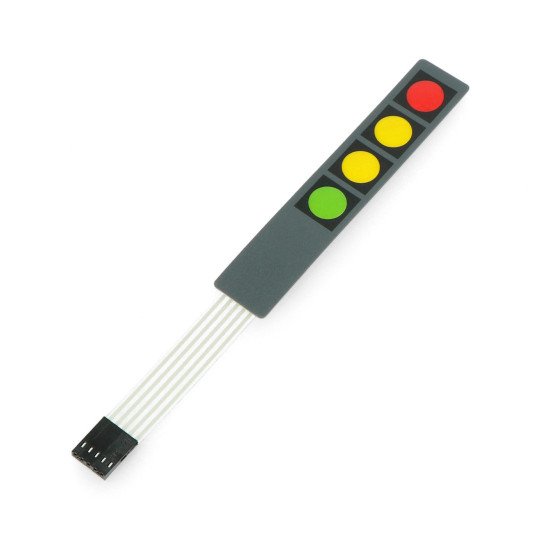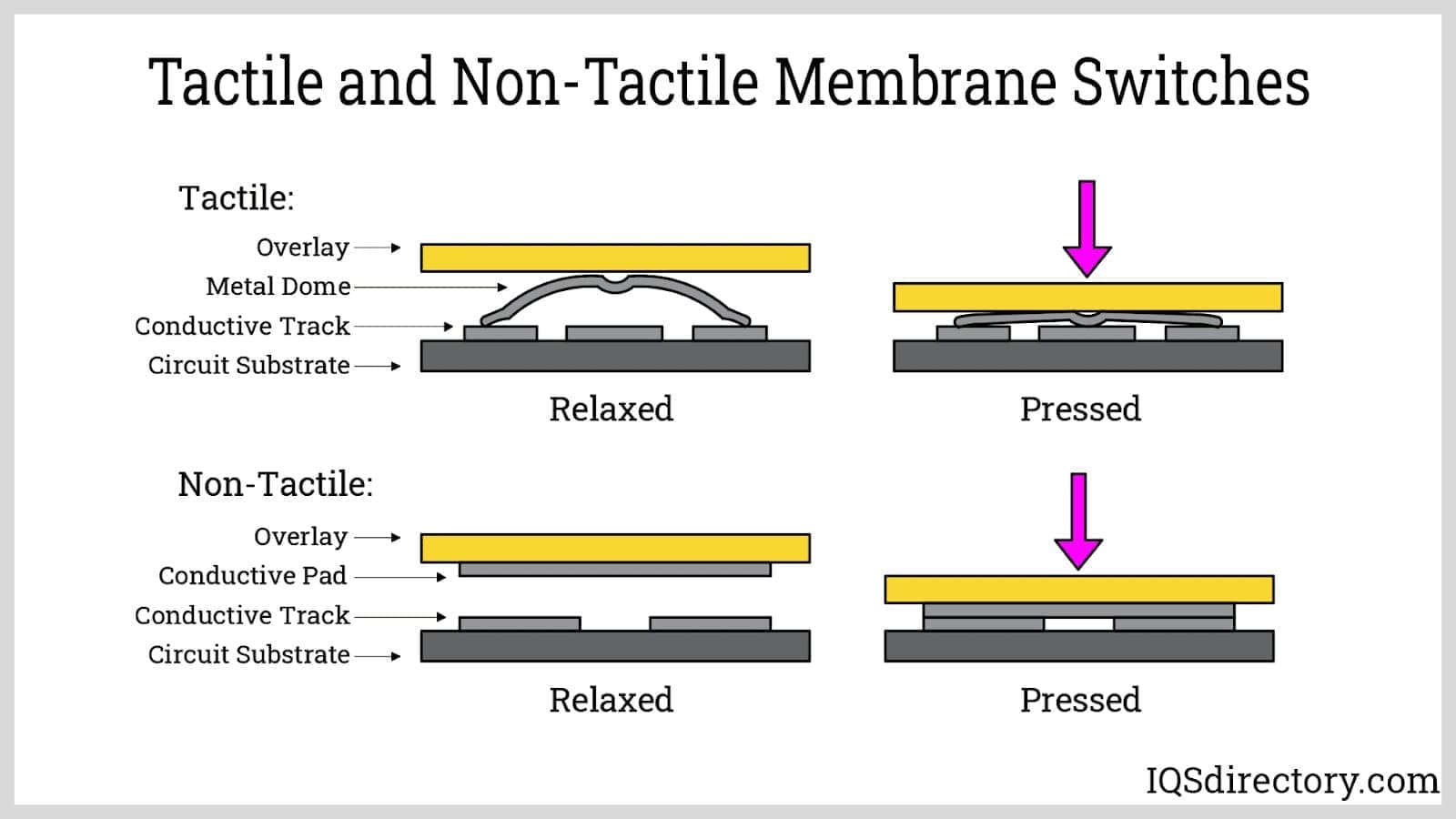Exploring the Manufacturing Process of Membrane Switch for Numerous Industries
The manufacturing process of Membrane switches is an intricate venture that demands accuracy and attention to information. From choosing ideal products to executing extensive quality control procedures, each action plays a crucial role in making sure capability. Various industries, consisting of clinical and automotive, depend on these components for their one-of-a-kind applications. Recognizing the details of this procedure reveals considerable insights into exactly how these buttons are generated and their effect throughout varied markets.
Comprehending Membrane Switches Over: An Introduction

Key Products Utilized in Membrane Switch Production
In Membrane switch production, the option of vital products significantly affects functionality and toughness. Conductive products, adhesives, and coatings play crucial roles, while substrate selection impacts total efficiency and reliability. Understanding these components is necessary for enhancing the design and production of Membrane buttons.
Conductive Products Review
Conductive products play an important duty in the performance of Membrane buttons, guaranteeing reliable electrical links within the device. Frequently made use of products include silver, copper, and carbon-based inks, each offering unique benefits. Silver is preferred for its high conductivity and resilience, making it suitable for applications requiring robust performance. Copper, while somewhat less conductive than silver, is a cost-effective option commonly made use of in published circuits. Carbon-based inks provide a flexible choice, appropriate for applications where adaptability and reduced prices are focused on, although they have actually reduced conductivity contrasted to steel alternatives. The selection of conductive materials directly affects the total dependability, life-span, and performance of the Membrane button, making it a vital consideration in the production process.
Adhesives and Coatings
Adhesives and coatings are important elements in the production of Membrane switches, offering crucial bonding and safety residential or commercial properties. These materials assure that various layers of the switch, consisting of visuals overlays and wiring, adhere securely to each other, boosting durability and capability. Generally made use of adhesives consist of pressure-sensitive adhesives (PSAs) and epoxy-based formulas, which use solid attachment and durability. Coatings, such as polyurethane or acrylic, serve to protect against environmental variables, consisting of moisture, abrasion, and chemicals. In addition, layers can boost tactile feedback and visual charm, contributing to the total individual experience. The selection of proper adhesives and finishes is important for optimizing efficiency and longevity in varied applications across different markets, ensuring that Membrane switches fulfill particular functional demands.
Substrate Option Aspects
Substratum option plays an essential function in the manufacturing of Membrane buttons, as it substantially influences their overall performance and longevity. Trick materials such as polyester, polycarbonate, and versatile printed circuit card (FPCBs) are generally utilized for their distinct residential or commercial properties. Polyester is favored for its cost-effectiveness and resistance to abrasion, making it suitable for applications with high wear. Polycarbonate offers premium clearness and influence resistance, ideal for environments requiring high visibility. FPCBs supply enhanced versatility and are usually made use of in intricate styles. The selection of substrate likewise affects elements like thermal security, chemical resistance, and ease of printing. Inevitably, picking the suitable substratum is essential for making sure the capability and long life of Membrane switches over across different industries.
The Style Refine of Membrane Switches
The design process of Membrane switches is a crucial phase that significantly affects the capability and visual appeals of the end product - membrane switch manufacturer. It starts with specifying the specific demands of the application, consisting of measurements, button design, and responsive responses choices. Developers have to think about customer communication, making certain that the button is instinctive and accessible.Next, materials are chosen based on toughness, versatility, and ecological resistance. The assimilation of graphics and branding components is additionally crucial, as it boosts aesthetic charm and communication. Prototyping permits for iterative screening, allowing modifications based on customer comments and performance evaluations.Additionally, the design must represent the electric parts, such as circuits and adapters, making sure dependability and ease of usage. Ultimately, a successful layout harmonizes performance, visual appeals, and individual experience, paving the way for effective manufacturing and resilient performance in numerous markets
Printing Methods for Membrane Switches Over
The printing techniques made use of in Membrane button manufacturing play a vital function in figuring out the final product's top quality and capability. Screen printing supplies advantages such as durability and vibrant shade application, while electronic printing innovations supply flexibility and precision in design. Understanding these approaches can substantially impact the total efficiency of Membrane buttons in various applications.
Screen Printing Benefits
Many benefits make display publishing a recommended technique for creating Membrane switches. This technique permits high-grade, dynamic shades and in-depth styles, which are essential for user interface applications. Display printing is specifically effective for applying thick ink layers, enhancing longevity and responsive responses. In enhancement, it offers superb adhesion to numerous substrates, making sure durability popular environments. The procedure is affordable for huge manufacturing runs, as it reduces arrangement time and waste. Display printing sustains a large range of inks, including specialty and UV-curable options, enabling adaptability in style. Its capacity to generate consistent outcomes across multiple devices makes it a dependable option for producers intending for high quality and efficiency in Membrane button manufacturing.
Digital Printing Innovations

Improvements in digital printing modern technology are changing the manufacturing of Membrane switches, providing manufacturers innovative remedies that improve style versatility and effectiveness. Digital printing allows for elaborate layouts and high-resolution graphics, making it possible for customized branding and functionality without the constraints of traditional approaches. This technique decreases setup times and expenses, helping with shorter production runs and marginal waste, making it perfect for services with differing demands. In addition, developments in ink solutions offer far better longevity and attachment, guaranteeing longevity in numerous settings. As industries significantly seek personalized and intricate styles, digital printing stands out as an important strategy, setting great site a brand-new criterion in Membrane button production. The integration of these innovations positions producers to satisfy evolving market needs successfully.
Setting up and Layering of Membrane Switch Components
Cautious setting up and layering of Membrane switch parts are important to guaranteeing capability and resilience. This process starts with the exact placement of various layers, consisting of the visuals overlay, adhesive, circuit layer, and backing material. Each element needs to be carefully placed to maintain electrical honesty and interface responsiveness.During setting up, conductive traces are used to the circuit layer, typically made from products like polyester or polycarbonate. This layer is critical, as it sends signals when stress is used. The glue made use of for bonding these layers is additionally chosen for its capability to endure environmental stresses while maintaining a protected bond.Heat and stress are often used throughout the assembly procedure to ascertain that the layers stick properly without compromising the capability of the switch. Interest is given to the edge sealing to shield against dampness and impurities, protecting the long life of the Membrane switch in different commercial applications.
Quality Assurance Procedures in Membrane Switch Manufacturing
Quality control measures play a crucial function in making certain the dependability and performance of Membrane changes complying with the setting up and layering of their parts. In the manufacturing process, a number of key examinations are performed to maintain top quality criteria. These include aesthetic inspections for flaws Read Full Report in printing and sticky application, along with practical examinations to confirm the responsiveness of each switch.Additionally, ecological testing is carried out to assess the switches' sturdiness against temperature changes and moisture direct exposure. Manufacturers often execute statistical process control (copyright) strategies to monitor manufacturing consistency, allowing early discovery of anomalies.Furthermore, traceability systems are established to track materials and components, ensuring responsibility and promoting recalls if needed. Calibration of tools and adherence to industry criteria are also crucial to keeping product stability. Collectively, these top quality control procedures protect the efficiency of Membrane switches over across various applications, ultimately boosting consumer complete satisfaction.
Applications of Membrane Switches Over Across Different Industries
Membrane switches are made use of throughout a varied variety of industries, showcasing their versatility and versatility. In the clinical sector, they supply waterproof and trusted interfaces for tools such as analysis devices and mixture pumps, making sure hygiene and simplicity of usage. The auto market uses Membrane switches for control panel controls, allowing seamless interaction between the driver and vehicle systems.In consumer electronic devices, these buttons are discovered in home appliances and portable tools, supplying a sleek, modern-day aesthetic while enhancing capability. Industrial applications additionally leverage Membrane changes for machinery control panels, where resilience and resistance to rough conditions are essential.Furthermore, the aerospace and protection industries use Membrane buttons for cabin instrumentation and interaction systems, prioritizing reliability and performance under extreme conditions. On the whole, Membrane buttons play an important role in boosting the user experience and operational performance across various domains.
Regularly Asked Inquiries
For how long Does It Take to Manufacture a Membrane Layer Switch?
The production time for a membrane layer switch generally varies from a few days to numerous weeks - membrane switch manufacturer. Elements influencing this period include layout intricacy, product accessibility, and production quantity, all influencing the general timeline considerably
What Is the Typical Lifespan of a Membrane Switch?
The typical lifespan of a membrane layer button usually varies from 1 to 5 million actuations, depending on elements such as material top quality, environmental problems, and usage regularity, significantly influencing resilience and general performance.
Can Membrane Switches Over Be Customized for Details Applications?
Membrane switches can indeed be personalized for specific applications. Their style adaptability enables alterations in size, form, colors, and graphics, ensuring compatibility with one-of-a-kind demands throughout different sectors and enhancing capability and customer go experience.

Are Membrane Changes Environmentally Pleasant?
The ecological effect of Membrane changes differs. Some materials utilized may not be eco-friendly, while improvements in manufacturing procedures are significantly concentrating on sustainability, intending to minimize waste and promote recyclable elements in their manufacturing.
What Are the Typical Failing Settings of Membrane Switches?
Typical failing modes of Membrane switches include delamination, glue failure, damage from usage, moisture ingress, and electric failings. These problems can substantially affect performance, performance, and life expectancy in various applications across various sectors. Membrane switches can be customized to fit specific style requirements, such as dimension, form, and functionality, making them extremely adaptable.The building typically entails multiple layers, including a visuals overlay, glue, and a circuit layer, which function with each other to develop a smooth customer experience. In Membrane button production, the selection of vital products significantly influences performance and sturdiness. The automotive sector uses Membrane switches for control panel controls, enabling smooth communication in between the vehicle driver and lorry systems.In customer electronic devices, these buttons are located in devices and portable gadgets, offering a smooth, modern visual while boosting performance. Industrial applications likewise take advantage of Membrane switches for equipment control panels, where longevity and resistance to rough problems are essential.Furthermore, the aerospace and protection industries make use of Membrane switches for cockpit instrumentation and interaction systems, prioritizing integrity and performance under severe problems. Membrane switches can certainly be customized for details applications.